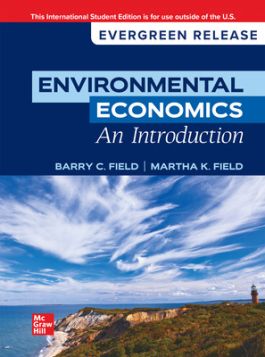Environmental Economics, An Introduction: 2024 Release ISE
1264698305
·
9781264698301
The 2024 Release from Martha & Barry Field, Environmental Economics: An Introduction is a comprehensive learning experience designed for students with limited to no economics background. This release has a brand-new print version, updated eBook, …
Leer Más
PRODUCTO DIGITAL EBOOK. NO ES UN PRODUCTO FÍSICO.
Gracias este es un libro electrónico o EBOOK, para poder utilizarlo debes de crear una cuenta en VitalSource Bookshelf esta es una Aplicación Gratis. Una vez que has creado tu cuenta, dentro de la plataforma debes de redimir los distintos códigos que hayas adquirido para poder leer tus libros.- Ingresa a tu libro desde cualquier lugar o dispositivo, con acceso a internet o sin acceso.
- Crear notas, y apuntes en tus lecturas.
- Puedes realizar búsquedas a los conceptos que necesites de manera rápida y fácil.
- Ingresa a tu libro desde cualquier lugar o dispositivo, con acceso a internet o sin acceso.
- Crear notas, y apuntes en tus lecturas.
- Puedes realizar búsquedas a los conceptos que necesites de manera rápida y fácil.
SECTION ONE: INTRODUCTION
1 What Is Environmental Economics?
2 The Economy and the Environment
SECTION TWO: ANALYTICAL TOOLS
3 Benefits and Costs, Supply and Demand
4 Markets, Externalities, and Public Goods
5 The Economics of Environmental Quality
SECTION THREE: ENVIRONMENTAL ANALYSIS
6 Frameworks of Analysis
7 Benefit–Cost Analysis Benefits
8 Benefit–Cost Analysis Costs
SECTION FOUR: ENVIRONMENTAL POLICY ANALYSIS
9 Criteria for Evaluating Environmental Policies
10 Decentralized Policies Liability Laws, Property Rights, Voluntary Action
11 Command-and-Control Strategies: The Case of Standards
12 Incentive-Based Strategies: Environmental Charges and Subsidies
13 Incentive-Based Strategies: Market Trading Systems
SECTION FIVE: ENVIRONMENTAL POLICY IN THE UNITED STATES
14 Federal Water Pollution Control Policy
15 Federal Air Pollution Control Policy
16 Federal Policy on Toxic and Hazardous Substances
17 State and Local Environmental Issues
SECTION SIX: GLOBAL ENVIRONMENTAL ISSUES
18 Global Climate Change
19 International Environmental Agreements
20 Globalization
21 Economic Development and the Environment
APPENDIX A: Abbreviations and Acronyms Used in the Book
APPENDIX B: Additional Websites
1 What Is Environmental Economics?
2 The Economy and the Environment
SECTION TWO: ANALYTICAL TOOLS
3 Benefits and Costs, Supply and Demand
4 Markets, Externalities, and Public Goods
5 The Economics of Environmental Quality
SECTION THREE: ENVIRONMENTAL ANALYSIS
6 Frameworks of Analysis
7 Benefit–Cost Analysis Benefits
8 Benefit–Cost Analysis Costs
SECTION FOUR: ENVIRONMENTAL POLICY ANALYSIS
9 Criteria for Evaluating Environmental Policies
10 Decentralized Policies Liability Laws, Property Rights, Voluntary Action
11 Command-and-Control Strategies: The Case of Standards
12 Incentive-Based Strategies: Environmental Charges and Subsidies
13 Incentive-Based Strategies: Market Trading Systems
SECTION FIVE: ENVIRONMENTAL POLICY IN THE UNITED STATES
14 Federal Water Pollution Control Policy
15 Federal Air Pollution Control Policy
16 Federal Policy on Toxic and Hazardous Substances
17 State and Local Environmental Issues
SECTION SIX: GLOBAL ENVIRONMENTAL ISSUES
18 Global Climate Change
19 International Environmental Agreements
20 Globalization
21 Economic Development and the Environment
APPENDIX A: Abbreviations and Acronyms Used in the Book
APPENDIX B: Additional Websites
The 2024 Release from Martha & Barry Field, Environmental Economics: An Introduction is a comprehensive learning experience designed for students with limited to no economics background. This release has a brand-new print version, updated eBook, and an innovative integration of digital content via Connect® for the first time ever, with SmartBook and a robust test bank. Explore a wealth of new and revitalized material: updated data and content, cutting-edge exhibits reflecting current global issues and real-world applications, refreshed figures, tables, sources, and references. Engage with thought-provoking end-of-chapter discussion questions that encourage critical thinking and application of knowledge. Enhancements include a shift in focus from "global warming" to "climate change," which takes a more prominent role throughout the text. The discussion of social and environmental justice topics has been significantly expanded, complemented by a comprehensive DEI review. This book is not just a guide; it's a call to action; to explore the intersection of economics and the environment, where informed decisions pave the way for a sustainable future.

